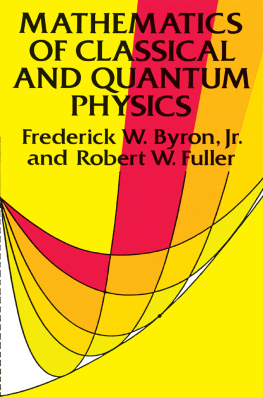Many different mathematical methods and concepts are used in classical mechanics: differential equations and phase flows, smooth mappings and manifolds, Lie groups and Lie algebras, symplectic geometry and ergodic theory. Many modern mathematical theories arose from problems in mechanics and only later acquired that axiomatic-abstract form which makes them so hard to study.
In this book we construct the mathematical apparatus of classical mechanics from the very beginning; thus, the reader is not assumed to have any previous knowledge beyond standard courses in analysis (differential and integral calculus, differential equations), geometry (vector spaces, vectors) and linear algebra (linear operators, quadratic forms).
With the help of this apparatus, we examine all the basic problems in dynamics, including the theory of oscillations, the theory of rigid body motion, and the hamiltonian formalism. The author has tried to show the geometric, qualitative aspect of phenomena. In this respect the book is closer to courses in theoretical mechanics for theoretical physicists than to traditional courses in theoretical mechanics as taught by mathematicians.
A considerable part of the book is devoted to variational principles and analytical dynamics. Characterizing analytical dynamics in his Lectures on the development of mathematics in the nineteenth century, F. Klein wrote that ... a physicist, for his problems, can extract from these theories only very little, and an engineer nothing. The development of the sciences in the following years decisively disproved this remark. Hamiltonian formalism lay at the basis of quantum mechanics and has become one of the most often used tools in the mathematical arsenal of physics. After the significance of symplectic structures and Huygens principle for all sorts of optimization problems was realized, Hamiltons equations began to be used constantly in engineering calculations. On the other hand, the contemporary development of celestial mechanics, connected with the requirements of space exploration, created new interest in the methods and problems of analytical dynamics.
The connections between classical mechanics and other areas of mathematics and physics are many and varied. The appendices to this book are devoted to a few of these connections. The apparatus of classical mechanics is applied to: the foundations of riemannian geometry, the dynamics of an ideal fluid, Kolmogorovs theory of perturbations of conditionally periodic motion, short-wave asymptotics for equations of mathematical physics, and the classification of caustics in geometrical optics.
These appendices are intended for the interested reader and are not part of the required general course. Some of them could constitute the basis of special courses (for example, on asymptotic methods in the theory of non-linear oscillations or on quasi-classical asymptotics). The appendices also contain some information of a reference nature (for example, a list of normal forms of quadratic hamiltonians). While in the basic chapters of the book the author has tried to develop all the proofs as explicitly as possible, avoiding references to other sources, the appendices consist on the whole of summaries of results, the proofs of which are to be found in the cited literature.
The basis for the book was a year-and-a-half-long required course in classical mechanics, taught by the author to third- and fourth-year mathematics students at the mathematics-mechanics faculty of Moscow State University in 19661968.
The author is grateful to I. G. Petrovsky, who insisted that these lectures be delivered, written up, and published. In preparing these lectures for publication, the author found very helpful the lecture notes of L. A. Bunimovich, L. D. Vaingortin, V. L. Novikov, and especially, the mimeographed edition (Moscow State University, 1968) organized by N. N. Kolesnikov. The author thanks them, and also all the students and colleagues who communicated their remarks on the mimeographed text; many of these remarks were used in the preparation of the present edition. The author is grateful to M. A. Leontovich, for suggesting the treatment of connections by means of a limit process, and also to I. I. Vorovich and V. I. Yudovich for their detailed review of the manuscript.
V. Arnold
The translators would like to thank Dr. R. Barrar for his help in reading the proofs. We would also like to thank many readers, especially Ted Courant, for spotting errors in the first two printings.
Berkeley, 1981
K. Vogtmann
A. Weinstein













